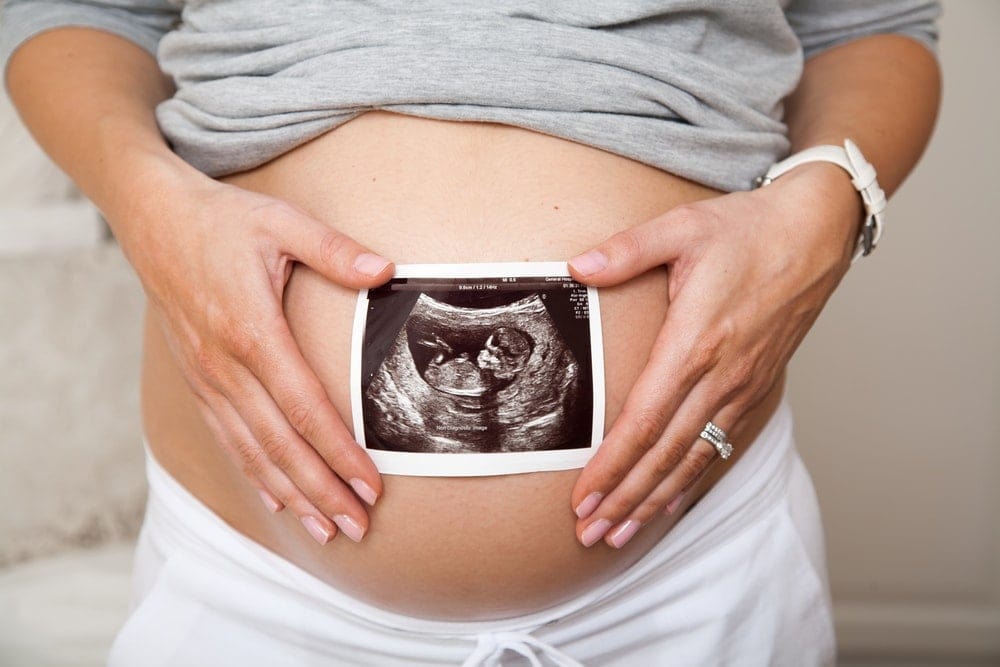Un sonograma es un procedimiento que utiliza ondas sonoras de alta frecuencia para escanear la cavidad del abdomen y la pelvis de una mujer, creaciendo una imagen (sonograma) de la bebé y la placenta . Las palabras de ultrasonido y sonograma son técnicamente diferentes, pero se utilizan indistintamente y hacen referencia al mismo examen.
¿Qué tipos de ultrasonidos hay?
Básicamente, hay siete exámenes de ultrasonido diferentes, pero el proceso es el mismo.
Los distintos tipos de procedimientos incluyen:
Ultrasonido Transvaginal – Los transductores de sonda especialmente diseñados son usados dentro de la vagina para generar imágenes de la ultrasonografía. Es usado más frecuente durante las primeras etapas del embarazo.
Ultrasonido Tradicional – El ultrasonido tradicional utiliza un transductor sobre el abdomen para generar imágenes 2-D del feto.
Ultrasonido Avanzada – Este examen es similar a el ultrasonido tradicional, pero el examen apunta a un problema sospechado y usa equipo más sofisticado.
Ultrasonido Doppler – Este procedimiento imagenológico mide cambios leves en la frecuencia de las ondas del ultrasonido como rebotan del movimiento de objetos, como células de la sangre.
Ultrasonido 3-D – Utiliza sondas especialmente diseñadas y software para generar imágenes en 3D del feto.
Ultrasonido 4-D o 3-D Dynamico – Uses specially designed scanners to look at the face and movements of the baby prior to delivery.
Ecocardiografía Fetal – Uses ultrasound waves to assess the baby’s heart anatomy and function. This is used to help assess suspected congenital heart defects.
How is an ultrasound performed?
The traditional ultrasound procedure involves placing gel on your abdomen to work as a conductor for the sound waves. Your healthcare provider uses a transducer to produce sound waves into the uterus. The sound waves bounce off bones and tissue returning back to the transducer to generate black and white images of the fetus.
When are ultrasounds performed?
Ultrasounds may be performed at any point during pregnancy, and the results are seen immediately on a monitor during the procedure. Transvaginal scans may be used early in pregnancy to diagnose potential ectopic or molar pregnancies.
There is not a recommended number of ultrasounds that should be performed during routine prenatal care. Because ultrasound should only be used when medically indicated, many healthy pregnancies will not require ultrasound. The average number of ultrasounds varies with each healthcare provider.
Additional ultrasounds might be ordered separately if your healthcare provider suspects a complication or problem related to your pregnancy.
What does the ultrasound look for?
Ultrasounds are diagnostic procedures that detect or aid in the detection of abnormalities and conditions related to pregnancy. Ultrasounds are usually combined with other tests, such as triple tests, amniocentesis, or chorionic villus sampling, to validate a diagnosis.
An ultrasound exam is medically indicated throughout pregnancy for the following reasons:
First Trimester:
- Confirm viable pregnancy
- Confirm heartbeat
- Measure the crown-rump length or gestational age
- Confirm molar or ectopic pregnancies
- Assess abnormal gestation
Second Trimester:
- Diagnose fetal malformation
- Weeks 13-14 for characteristics of potential Down syndrome
- Weeks 18-20 for congenital malformations
- Structural abnormalities
- Confirm multiples pregnancy
- Verify dates and growth
- Confirm intrauterine death
- Identify hydramnios or oligohydramnios – excessive or reduced levels of amniotic fluid
- Evaluation of fetal well-being
Third Trimester:
- Identify placental location
- Confirm intrauterine death
- Observe fetal presentation
- Observe fetal movements
- Identify uterine and pelvic abnormalities of the mother
What are the risks and side effects to the mother or baby?
The ultrasound is a noninvasive procedure which, when used properly, has not demonstrated fetal harm. The long term effects of repeated ultrasound exposures on the fetus are not fully known. It is recommended that ultrasound only be used if medically indicated.
Answers to common questions related to an ultrasound/ sonogram exam:
If an ultrasound is done at 6 to 7 weeks and a heartbeat is not detected, does that mean there is a problem?
No, it does not mean there is a problem. The heartbeat may not be detected for reasons that include: tipped uterus, larger abdomen, or inaccurate dating with last menstrual period. Heartbeats are best detected with transvaginal ultrasounds early in pregnancy.
Concern typically develops if there is no fetal heart activity in an embryo with a crown-rump length greater than 5mm. If you receive an ultrasound exam after week 6, your healthcare provider will begin to be concerned, if there is no gestational sac.
How accurate are ultrasounds in calculating gestational age?
Your healthcare provider will use hormone levels in your blood, the date of your last menstrual period and, in some cases, results from an ultrasound to generate an estimated gestational age. However, variations in each woman’s cycle and each pregnancy may hinder the accuracy of the gestational age calculation.
If your healthcare provider uses an ultrasound to get an estimated delivery date to base the timing of your prenatal care, the original estimated gestational age will not be changed.
Why do some healthcare providers schedule ultrasounds differently?
If there are any questions regarding gestational age, placenta location, or possible complications then more ultrasounds may be scheduled. Because ultrasound should only be used when medically indicated, many healthy pregnancies will not require ultrasound. The average number of ultrasounds varies with each healthcare provider.
How accurate are ultrasounds in determining the conception date to determine paternity?
Your healthcare provider will use hormone levels in your blood, the date of your last menstrual period and, in some cases, results from an ultrasound to generate an expected date of conception. However, many differences in each woman’s cycle may hinder the accuracy of the conception date calculation.
The viability of sperm varies as well, which means intercourse three to five days prior to ovulation may result in conception. Ultrasound dating of conception is not reliable for determining paternity because the ultrasound can be off by at least 5-7 days in early pregnancy.
When can an ultrasound determine the sex of the baby?
You may have an ultrasound between 18 to 20 weeks to evaluate dates, a multiples pregnancy, placenta location or complications. It may also be possible to determine the gender of your baby during this ultrasound. Several factors, such as the stage of pregnancy and position of fetus, will influence the accuracy of the gender prediction.
To be 100% sure you will have an anxious wait until the birth!
Are ultrasounds a necessary part of prenatal care?
Ultrasounds are only necessary if there is a medical concern. As noted above, ultrasounds enable your healthcare provider to evaluate the baby’s well being as well as diagnose potential problems. For women with an uncomplicated pregnancy, an ultrasound is not a necessary part of prenatal care.
Last Updated: 07/2015
Compiled using information from the following sources:
William�s Obstetrics Twenty-Second Ed. Cunningham, F. Gary, et al, Ch. 16.
American Institute of Ultrasound in Medicine, https://www.aium.org/






